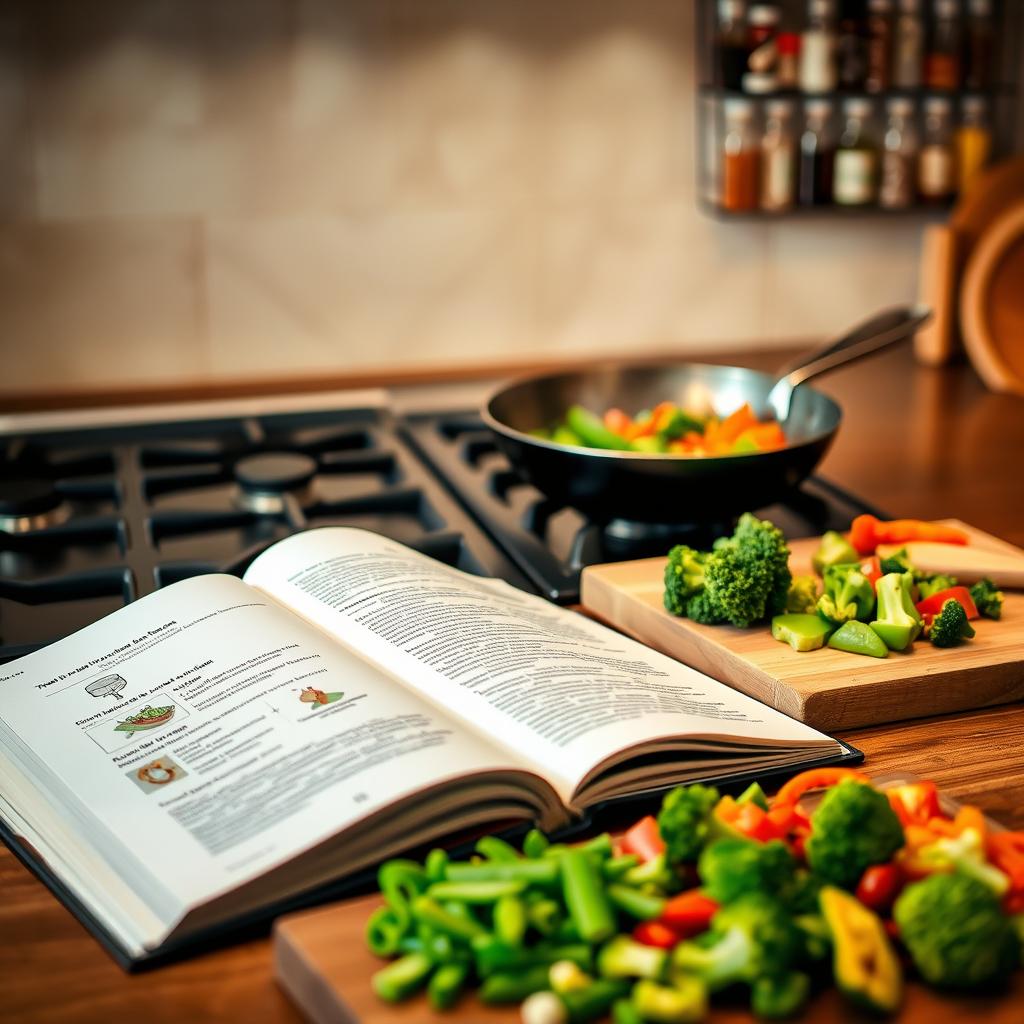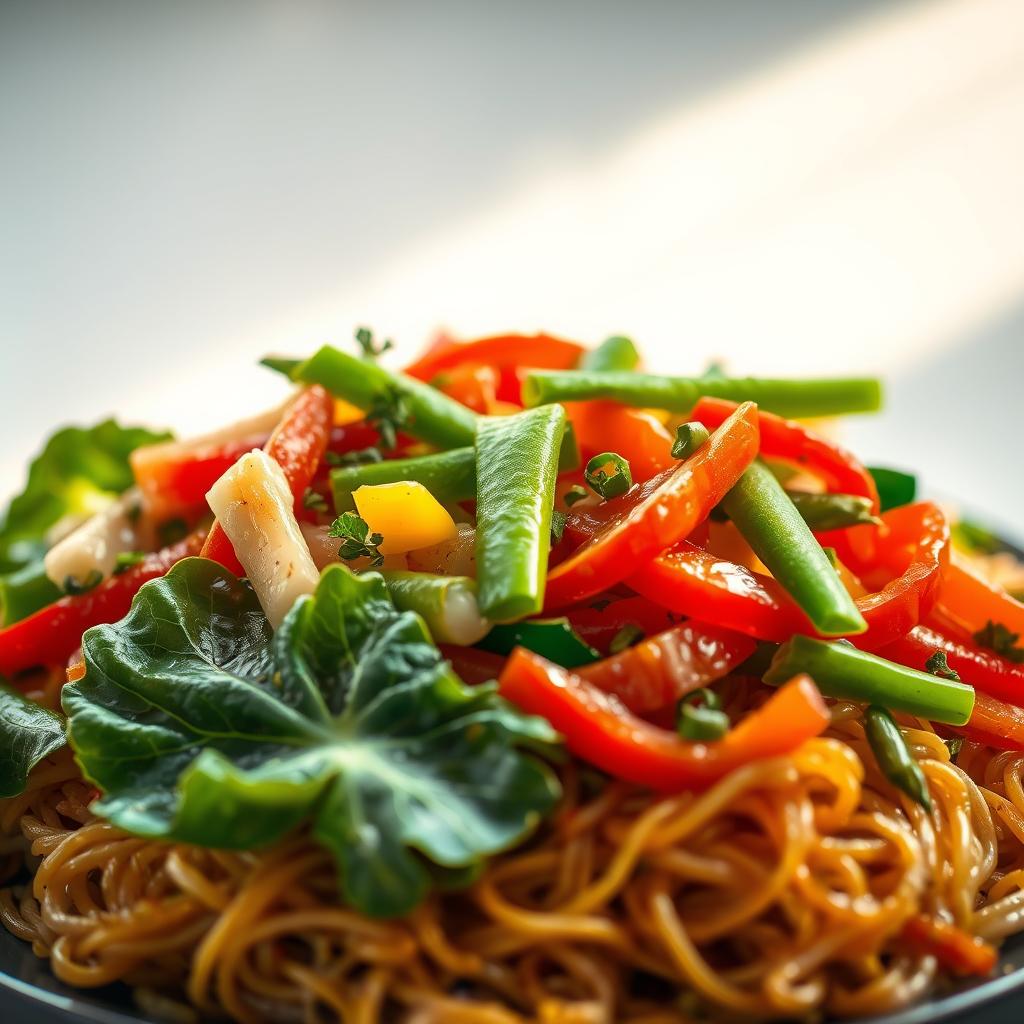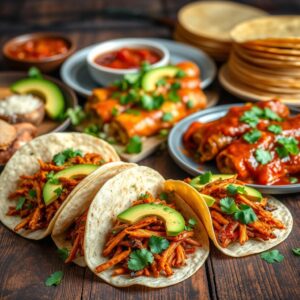vegan stir fry recipes are the quickest way to a colorful, satisfying dinner that keeps vegetables crisp and flavor bold. Do you believe you need hours or fancy tools to get restaurant-style results, or can you master a fast, tasty meal in under 30 minutes?
You’ll learn the pro sequence: aromatics first, sturdy veg next, delicate veg last, then finish with just enough sauce to glaze. A simple homemade sauce mixes tamari or soy, rice vinegar, garlic, ginger, and a starch so it clings without turning your veggies soggy.
Marinated tofu or quick-cooked mushrooms pair with brown rice, quinoa, or noodles for a hearty base. Use a hot wok or large skillet and you can have a lively, healthy meal in about 20–30 minutes that fits weeknights and meal prep.
Key Takeaways
- Follow a timed sequence to keep vegetables crisp and sauce glossy.
- Keep a basic sauce on hand: tamari/soy, vinegar, garlic, ginger, starch.
- Marinate tofu in a jar or use quick frozen mixes to save minutes.
- Choose brown rice, quinoa, or noodles as simple bases.
- A wok or large skillet helps control heat and moisture for better flavor.
- Use the master method to build many variations from one core recipe.
Vegan stir fry recipes you can cook tonight: what you’ll learn
Turn fridge odds and ends into a bright, saucy meal that cooks in minutes and keeps vegetables crisp.
What you’ll master: a 20-minute workflow that starts with a five-minute sweet‑savory sauce (low-sodium soy sauce or tamari, rice vinegar, sesame oil, garlic, ginger, cornstarch, and water) and moves to high-heat cooking: 3–4 minutes for most vegetables, then 1–2 minutes to thicken the glaze.
You’ll learn simple prep, how to cut veg for even cooking, and quick add-ins like baked tofu or tempeh. The sauce keeps in the fridge up to a week or freezes for three months, so future dinners come together faster.
- Fast sequence: prep, high heat fry, finish with sauce.
- Pantry ingredients to keep on hand for instant flavor.
- Time targets: aim for 20–30 minutes total.
- Links to technique primers to speed learning: wok basics and stir-fry tips.
| Step | Time | Key action |
|---|---|---|
| Make sauce | 5 minutes | Whisk soy, vinegar, sesame oil, garlic, ginger, cornstarch, water |
| Cook vegetables | 3–4 minutes | High heat, keep pieces similar size |
| Finish | 1–2 minutes | Add sauce, thicken, add tofu, serve over rice/noodles |
Master the stir-fry technique: crisp-tender vegetables, not soggy
Start by perfuming the pan with aromatics so every bite carries bright flavor.
Begin on high heat. Add garlic, ginger, onions, and baby bella mushrooms first to scent the pan. Let them color briefly, then push them to the edge.
Stage your vegetables for even cooking
- Next add sturdy items — broccoli, carrots, cauliflower — so they get time to brown.
- Finish with quick-cooking veg like red bell peppers, zucchini, and bok choy.
- Hold the sauce until the vegetables are crisp-tender to avoid sogginess.
Why a wok or wide skillet matters
A carbon-steel wok or wide skillet gives surface area for searing. That contact drives off moisture so things fry instead of steam.
Cut size, crowding, and moisture control
Cut pieces evenly so they cook in similar minutes. Avoid crowding; cook in batches if needed. Use minimal oil or a splash of water or broth if veg stick, then return to high heat.
Pro tip: Toss quickly once the sauce hits; the starch should thicken and glaze in about a minute. Look for bright color and slight browning as your cue to serve.
Build a bold stir fry sauce (soy sauce, rice vinegar, garlic, ginger)
Start with a simple five-part framework to make a sauce that glazes without sogginess.
Core formula: salty (low-sodium soy sauce or tamari), sweet (pineapple, maple, or a bit of brown sugar), tangy rice vinegar, umami from garlic and ginger, plus a thickener whisked with water.
Arrowroot vs. cornstarch and timing
Arrowroot gives a clear, glossy finish and thickens at lower heat. Cornstarch is reliable and easy to find.
Whisk 1 teaspoon to 1 tablespoons of starch per cup of liquid. Stir the mix right before you pour—the starch settles fast.
Refined-sugar-free options
Blend fresh pineapple with a little water or use maple syrup for sweetness. Brown sugar is another pantry-friendly choice that works well.
- Use 1/4–1/2 cup of sauce to glaze a panful of vegetable and protein.
- Add sauce at the end and simmer 1–2 minutes until shiny.
- Keep a jarred batch in the fridge for quick weeknight use; add a drop of sesame oil if you want nutty depth.
Protein power: tofu, tempeh, and edamame for a satisfying vegan stir fry
Good protein prep turns quick meals into reliable weeknight favorites. Press extra-firm tofu for about 20 minutes to remove water so your pan sears instead of steams. That step helps the cubes absorb more sauce and hold texture under high heat.
Press, marinate, and bake or air-fry for maximum flavor
Cut pressed tofu into cubes and add to a 1‑quart mason jar with soy/tamari, rice vinegar, minced garlic, grated ginger, and a touch of starch. Shake, chill, then bake or air‑fry at 375°F for 15–20 minutes, flipping once.
Mason jar marinades: make-ahead convenience
Reserve the marinade and simmer it into a glossy glaze to finish the vegetables. Prefer tempeh or edamame? Steam tempeh briefly to reduce bitterness, or toss thawed edamame in the hot pan at the end for a bright pop.
“Make two trays on Sunday and you’ve got protein that fits noodles, rice bowls, or leftovers.”
- Go oil-free: dry-bake or air-fry and use a splash of water in the skillet.
- Combine tofu and edamame for texture and a fuller amino profile.
- Reheat gently over medium to keep the exterior pleasantly firm.
Choose your base: brown rice, quinoa, or noodles
Start by deciding if you want chewy rice, nutty quinoa, or slurpable noodles. Cook brown rice or quinoa ahead on the weekend so your base is ready when the vegetables are hot.
Portion and plating: Spoon about a cup of base per serving, then mound twice as many vegetables as rice or noodles. That vegetable-forward ratio keeps meals lighter and more nutrient-dense.
Gluten-free swaps: Use tamari instead of standard soy and choose certified rice noodles when you need GF options. Toss noodles with a teaspoon of tamari before plating to season and keep them springy.
- Batch-cook brown rice or quinoa for fast assembly.
- Rotate bases across the week to avoid repetition.
- Drizzle only enough sauce to glaze — the base should catch the extra.
- Finish with black sesame seeds for a nutty pop without extra effort.
| Base | When to use | Storage tip |
|---|---|---|
| Brown rice | Meal prep, hearty bowls | Reheat well; portion separately |
| Quinoa | Higher-protein option | Fluff before serving |
| Rice noodles | Quick nights, slurpable bowls | Toss with tamari to prevent clumping |
“Plate more vegetables than grain and your lunches will be fresher and more satisfying.”
Weeknight shortcut: frozen vegetables + five-minute stir-fry sauce

Short on time? Keep a plain frozen vegetable blend and a shaken sauce jar to turn frozen goods into a quick dinner.
From freezer to wok: crisp-tender results in minutes
Start with mushrooms. Sear them in a hot skillet with a splash of vegetable broth to drive off moisture and build flavor.
Drop the unsauced frozen vegetables straight into the hot pan. Keep the heat high so the mix fries instead of steaming.
- Shake a five-minute sauce in a jar and pour just enough to glaze; cornstarch will thicken it almost instantly.
- Fold in pre-baked tofu cubes from the fridge for protein; they will firm up though not get crispy without breading or extra oil.
- Spoon the finished mix over a warm cup of rice for a full meal.
- Use water or broth instead of extra oil to keep it light and plant-forward.
| Step | Key action | Time |
|---|---|---|
| Sear mushrooms | High heat, splash of broth to brown and dry surface | 2–3 minutes |
| Add frozen mix | Keep flame high, toss sparingly so veg stay crisp-tender | 3–4 minutes |
| Finish | Stir in sauce with cornstarch, add tofu, serve over rice | 1–2 minutes |
Tip: Taste at the end and add a little more sauce or vinegar if needed. Rinse the jar and mix your next batch so you can repeat this shortcut in minutes.
Ingredient swaps and additions to vary flavor and texture
A few smart ingredient swaps unlock new profiles from the same base technique.
You can choose tamari instead of soy sauce when you need a gluten-free option without losing umami. Use low-sodium versions and thin with a little water if the sauce tastes too salty.
Add toasted sesame oil at the end for nutty depth. For high-heat sautéing, use olive oil or a neutral oil so you don’t scorch delicate aromatics.
Heat and texture boosts
Turn up the spice with red pepper flakes or a dash of sriracha. Balance heat by adding a touch of maple or a small amount of sugar to the sauce.
Rotate your vegetables: broccoli, mushrooms, bell peppers, snap peas, bok choy, asparagus, napa cabbage, and baby corn each bring different textures.
- For crunch, toss in water chestnuts.
- For sweetness, add frozen or fresh peas.
- Finish with a sprinkle of sesame seeds for aroma and contrast.
“Small ingredient swaps keep the core method fresh and make weekly meal planning simpler.”
| Swap | When to use | Effect on dish |
|---|---|---|
| Tamari vs soy sauce | Gluten-free or lower-sodium | Same umami, less gluten risk |
| Sesame oil vs olive oil | Finishing vs high-heat cooking | Nutty finish vs stable sauté base |
| Water chestnuts / peas | Textural contrast | Crisp crunch / sweet pop in glaze |
Step-by-step timeline: dinner in about 20-30 minutes
Follow a tight timeline so you spend less time guessing and more time eating. This plan keeps your pan hot and your ingredients moving for a glossy finish in about half an hour.
Your minute-by-minute game plan from prep to plate
- Minute 0–5: Whisk or shake your sauce. Mince garlic and ginger — one to two cloves, to taste.
- Minute 5–10: Preheat your wok or skillet over high heat. Line up vegetables and any baked tofu.
- Minute 10–14: Stir aromatics and sturdy vegetables first so they brown and hold texture.
- Minute 14–18: Add quick-cooking vegetables; stir just enough to sear without steaming.
- Minute 18–20: Pour in the sauce and simmer 1–2 minutes until glossy and thick.
- Minute 20–22: Fold in baked tofu if using; warm through without overcooking the vegetables.
- Minute 22–25: Plate over rice or noodles; finish with sesame seeds and adjust seasoning.
- Minute 25–30: Wipe the pan, cool, and store leftovers; label for next-day lunches.
Save time: Chop vegetables in the morning and batch your sauce on Sundays. The sauce keeps up to a week in the fridge or freezes for three months.
| Phase | Minutes | Key action | Why it matters |
|---|---|---|---|
| Prep | 0–5 | Make sauce; mince garlic & ginger | Speeds assembly and locks flavor |
| Cook | 10–18 | High heat in wok/skillet; stage vegetables | Prevents sogginess; preserves color |
| Finish | 18–22 | Add sauce; thicken; fold in tofu | Creates a glossy glaze and warms protein |
| Plate & store | 22–30 | Serve over rice; cool and pack leftovers | Fast cleanup and ready lunches |
Keep the heat high so you fry, not stew, and you’ll hit these minutes without stress. A small plan saves time and yields a better stir fry every meal.
External inspiration and trusted guides for vegan stir-fry success

Bookmark a short list of expert guides so you can deepen technique and expand sauce ideas at your own pace.
Use these dofollow references when you want clear heat control, tested sauce formulas, or reliable protein prep.
Technique and sauce references worth bookmarking
- Level up wok skills and heat management with Serious Eats: Serious Eats — stir-frying basics.
- Master vegetable timing and quick pan techniques at The Woks of Life: The Woks of Life — how to stir-fry.
- Nail crisp-ish baked tofu and simple sauce pairings via Minimalist Baker: Minimalist Baker — how to make tofu 5 ways.
- Find diverse sauces, noodles, and bowl ideas on Vegan Richa: Vegan Richa — sauces & noodle bowls.
Beyond links, focus on a few practical learnings: compare low-sodium soy sauce to avoid oversalting. Add a dash of sesame oil at the end for aroma, not for high heat.
Decide whether to use a wok or a skillet based on your burner and pan material. Use olive oil or a neutral oil for high-heat searing and reserve sesame for finishing.
| Topic | What to learn | Quick tip |
|---|---|---|
| Heat control | Wok vs skillet use | Keep pan hot; cook in batches |
| Sauce balance | Salt, sweet, acid, starch | Whisk starch with water before adding |
| Protein & noodles | Tofu texture & noodle handling | Bake tofu; toss noodles with a little sauce |
“Keep these resources bookmarked as dofollow references for continuous learning.”
How to make multiple vegan stir fry recipes from one master method
Whip one dependable method into many dinners by swapping a few core components. Make a single jar of sauce and you can build varied bowls all week. This keeps prep low and results consistent.
Mix-and-match vegetables, proteins, and sauces for endless variety
Use one master sauce to cover about a cup of sauce per panful; one batch typically glazes roughly 8 cups of raw vegetables evenly.
Mix broccoli, carrots, peppers, snap peas, and mushrooms for texture contrast. Rotate proteins—baked tofu, tempeh, or edamame—added at the end to warm through.
Meal prep tips: cook grains ahead, batch sauce, store safely
Batch-cook rice, quinoa, or noodles on Sunday and cool quickly. Store grains airtight and label with dates so you save time during the week.
Keep sauce in the fridge up to 1 week or freeze for 3 months. Shake the jar to re-suspend starch before use. Add a little water if the mix tastes too salty and simmer 1–2 minutes to lock in flavor and sheen.
| Prep task | How to store | Why it helps |
|---|---|---|
| Grains (rice/noodles) | Airtight, refrigerated 3–5 days | Fast assembly, consistent texture |
| Master sauce | Fridge 1 week / Freezer 3 months | One jar covers many meals |
| Baked tofu | Cool, airtight, 4 days | Ready protein; reheats quickly |
“Track combos you love so ‘mix-and-match’ becomes a personal playbook of reliable favorites.”
- Set a house ratio with tablespoons and a teaspoon for quick measuring.
- Aim for about 8 cups of vegetables per sauce batch for ideal glaze.
- Reheat gently to keep vegetables crisp-tender; add extra sauce only at the end.
Conclusion
Wrap it up: finish the sauce last, toss briefly, and serve while vegetables stay crisp and bright. ,
You now have a repeatable way to stir and stir fry vibrant vegetables and lock in a glossy finish.
Keep bowls vegetable-forward, spoon a little rice under the mix, and finish with sesame seeds for crunch. Use the stir-fry sauce framework to tweak tang, heat, and sweetness to your taste.
Lean on frozen shortcuts and make-ahead sauce and grains to shave time. Mix proteins and produce to keep your vegan stir fry exciting all week long. Bookmark the expert links and grab your wok or skillet tonight to make this recipe your own.




